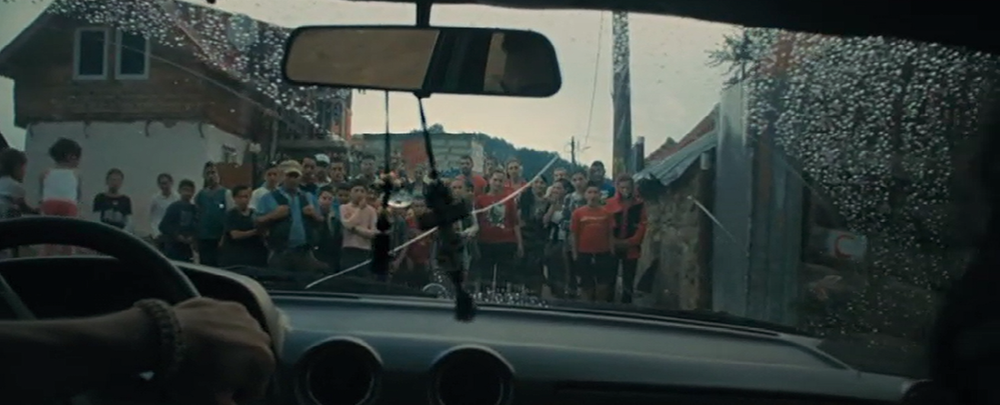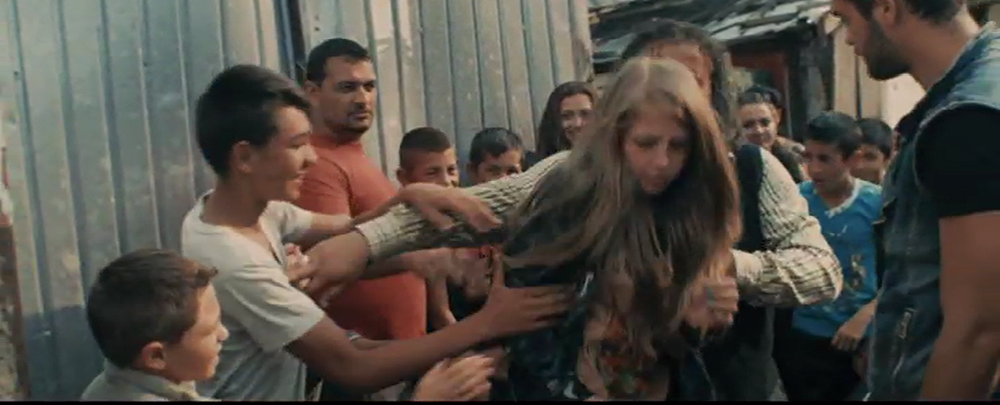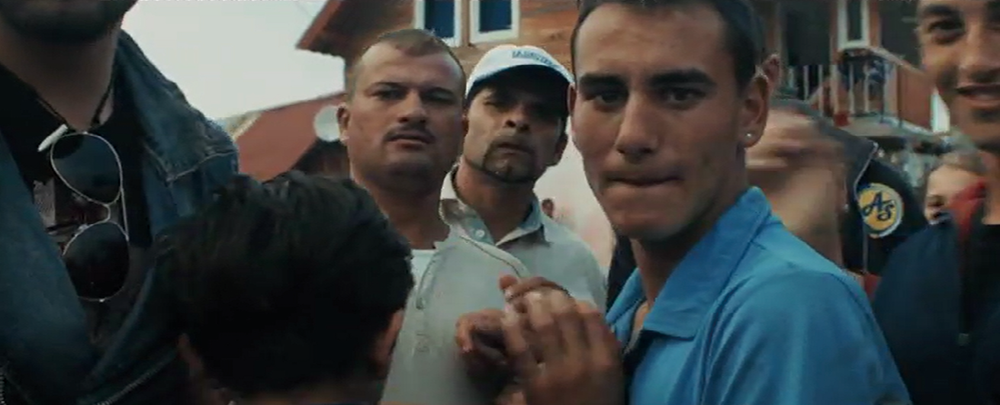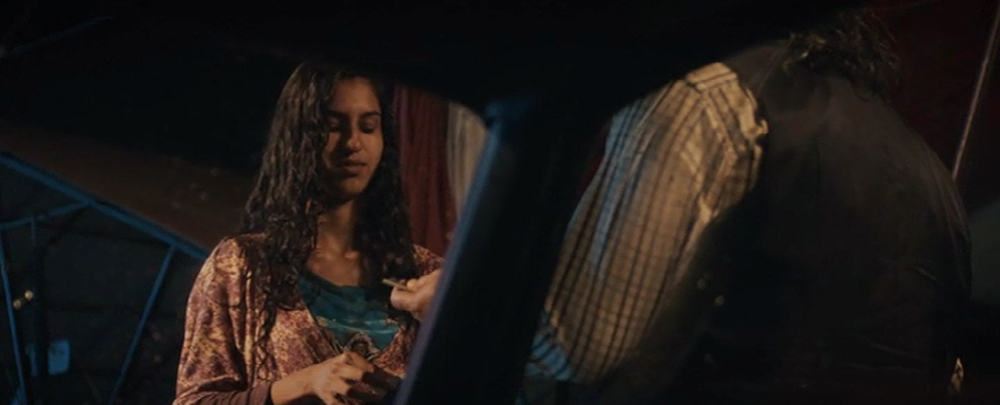When Good Intentions Go Bad: The Stereotypical Portrayal of Roma Characters in the German Children and Youth Film Nellys Abenteuer
The tax-funded film Nellys Abenteuer (Nelly’s Adventure) was supposed to be an educational tool to foster intercultural understanding among children. Yet, the film (re-)produces a line of difference between Germans and Roma and was therefore strongly criticised. Although the director wanted to show that, through their relationships, the Roma characters evolve and grow in their moral thinking, they are nonetheless portrayed as stereotypical images.
The film for children and young adults was produced in Germany and Romania and was first shown in cinemas in 2016. The broadcast of the film by the German public television station Südwestrundfunk on November 12th, 2017, and later on by the children’s television channel Kinderkanal, was accompanied by a public debate about antigypsyism in film. Several meetings between the film team (mainly the producers, screenwriters, and director), the TV-stations, and the Central Council of German Sinti and Roma took place ahead of the planned broadcasting. In addition, more than a dozen statements were published by the Central Council, the film team, organizations of Sinti and Roma, and others. The Central Council published a review of the portrayal of Roma in Nellys Abenteuer and a one-hour TV debate followed the broadcast of the film on Südwestrundfunk.
The Central Council criticised that Roma in the film were portrayed according to antigypsyist stereotypes and argued that the film enhances antigypsyism among children. The Roma’s activities and characteristics in the film follow antigypsyist tropes. According to such tropes, Roma appear in the film as small-time criminals, con artists, beggars, as doing ‘traditional’ dances, as kidnappers of children, etc. In contrast, the film team proclaimed that the critics had not understood the film and insisted on good intentions and on the film’s message of evoking understanding among different cultures.
The storyline of the film is as follows: Nelly and her parents, the Klabunt family from Germany, are planning to spend their summer holidays in Romania. There, Nelly learns that her parents plan to move to Romania due to a job opportunity for her father. Furious about this, Nelly runs away and gets kidnapped by two Roma, Hokus and Iancu, who hide her in a Roma village. It turns out that the German non-Roma Reginald Wagner is behind the kidnapping of Nelly, with the aim of preventing her father from working on wind energy development in Romania, which competes with Wagner’s dam project. Nelly is finally successful in escaping with the help of Tibi and Roxana, two Roma children from the village. Together the children fight Wagner and save the Roma village, which is endangered from flooding by his dam project. At the end of the film, Nelly and her parents decide to move to Romania.
Now, what is it about this film that caused such a heated public debate? In order to discuss this question, I will address key points concerning both the film and the debate. First, I will examine whether a difference between Roma and non-Roma is (re-)produced in the film, and if so, in what way is this problematic? Second, by explaining how the academic areas of film studies and minority studies differ in their understandings of what a character is and what a stereotype is, I will be able to discuss the relationship between the film team’s intention (they claimed to have anti-racist objectives) and the actual film product. Third, I will analyse two scenes from the film in order to emphasise how stereotypical images are inscribed in what appears on the film’s surface – its manifest meaning structure – and in what needs to be detangled – the film’s latent meaning structure. I will argue that a film is always an expression of a society’s collective visual memory.
Nellys Abenteuer is of specific interest for several reasons. First, the film was well placed to succeed: Nellys Abenteuer was financed with over 900,000 euros worth of tax money, was shown at a variety of film festivals, won multiple awards, and was produced in cooperation with public television, namely Südwestrundfunk and Saarländischer Rundfunk. Most importantly, the film’s target audience is children. The film’s website provided a contact address for schools that would like to screen the film as well as a link to “extensive educational materials.” Today, the film’s website still makes material available for download but the strongly criticised “educational material” has disappeared from the website. Children are often regarded with specific concern as they are connected to ideas of innocence, hope, and the future. Therefore, a strong reaction to a film that is perceived as enhancing antigypsyist stereotypes is not surprising, as such a film contradicts pedagogical efforts against antigypsyism. The film’s impact on children was one of the central topics of the debate. In this context, an impact study was conducted by Maja Götz and Andrea Holler from the International Central Institute for Youth and Educational Television. In addition to the aforementioned aspects, I will also discuss the results and the methodology of the impact study.
Creating Difference in Nellys Abenteuer
Despite being a story about the developing friendship between Nelly and the two children from the Roma village, Tibi and Roxana, the film (re-)produces an essentialised difference between Roma and non-Roma. The line of difference becomes evident by examining both the film’s content and its form.
At the beginning of the film, Nelly’s father is introduced as permanently busy with his smartphone. He has no time for his wife and daughter. Similarly, Nelly’s mother is described by her daughter as “very stressy.” She is portrayed as a person who educates her daughter to be diligent and to always endeavour: “If you are not practicing on a regular basis, it will all come to nothing!” is what she says to rebuke Nelly when she refuses to take her flute with her to their family holidays in Romania [00:02:38–00:02:40]. The German Klabunt family is introduced and portrayed as a disciplined and hard-working family from a German townhouse in Schwäbisch-Hall.
The portrayal of Nelly’s home in Germany could hardly differ more from what she experiences during her first encounter with the Roma village. The scene in Germany takes place in a clean and modern middleclass townhouse that appears in bright light, filmed with a stable, cinematic camera. In contrast, the Roma village appears as pre-modern, dirty, and is shown in a dark and rainy environment. Here, Nelly finds herself in a totally different setting when she arrives, just after being kidnapped, in the Roma village. The entrance to the village is filmed from the inside of the car. At first, approximately 50 percent of the screen is occupied by the car. This way, a barrier to the outside is constructed. The viewer finds him- or herself at a distance from the outside and also in discomfort because the car wobbles due to the bad condition of the street. As the car slowly occupies less space on the screen, the Roma village appears (Fig. 1). Here, a group of people stand shoulder to shoulder to watch the arrival. Gloomy sounds underscore the impression of foreignness and intimidation.
Now, the camera shows Nelly’s arrival from two perspectives: First, the third-person camera is on Nelly, who is surrounded, touched, and intimidated by the Roma from the village (Fig. 2). Hokus guides her through the group.
Second, the first-person camera takes Nelly’s perspective (Fig. 3). Whereas the camera from the car created distance, the camera’s perspective now demonstrates the encroaching attack on Nelly’s privacy [00:36:04–00:37:03].
This scene not only creates a difference between Nelly and the village people, but is also reflective of the deep-rooted antigypsyist stereotype of Roma not being able to respect personal boundaries, instead being undisciplined and carefree. Furthermore, the unstable, wobbling, documentary camera style intensifies not only the perception of an uncomfortable and threatening environment but also the perception of difference between Roma (represented by the people from the village) and Germans (represented by Nelly); the civilised, modern, and disciplined Germans on the one side, and the uncivilised, pre-modern and undisciplined Roma on the other.
The documentary camera style strengthens the notion of authenticity. Interestingly, the film team proclaimed that specific scenes of Nellys Abenteuer were filmed in a real Roma village and that these scenes are therefore authentic. At the same time however, they proclaimed that Nellys Abenteuer is a feature film that will not be perceived as authentic or real by the audience. While ambivalence remains, there is more: Besides the frequent use of a documentary camera style when Roma are portrayed, the film’s setting in Romania needs critical attention. “The closer to ‘home,’ the more ‘authentic’ the film” may be the logic here. Romanians are frequently perceived as Roma and vice versa. In addition, it is worth mentioning that Nellys Abenteuer is Dominik Wessely’s first feature film as a director. Before that, he was the director of more than fifteen documentaries. To choose a documentary filmmaker for Nellys Abenteuer may be interpreted as an expression of the longing for authenticity when it comes to Roma film figures in German film productions. In Nellys Abenteuer, the stereotypical portrayal continues in supposedly ‘positive’ displays: In addition to the negative stereotypes described above, viewers are also shown a romanticised image of a presumably joyful life filled with dance, card tricks, music, and ‘traditional’ clothing. These representations of alleged ‘traditions’ do not break with stereotypical portrayals, but rather complement them. Fascination and disdain are two sides of the same coin.
Stereotypes & Characters – Film Figures as Symptoms of the Collective Visual Memory
How stable is the created line of difference between Roma and non-Roma? Does the development of friendship between Nelly, Roxana, and Tibi break through this line of difference? The screenwriter of Nellys Abenteuer, Jens Becker, wrote in a statement that Tibi, Roxana, their mother Roza and the kidnapper Hokus are characters in the sense that each and every one of them has his or her own character arc. In fact, there is no doubt that Tibi, Roxana, and Roza are, from Nelly’s perspective, at first a threat but later allies. However, at the same time, these characters are portrayed stereotypically throughout the film. It is important to understand that the term “stereotype” means something different in film making than in social psychology: While a stereotype in the field of social science is understood as an ingrained prejudice, a stereotype in film theory is understood as a figure that has a function without depth or development (in contrast to a character). A figure-stereotype (“Figurenstereotyp”) does not have to be identical with the social psychological understanding of a stereotype. However, film characters can be based on a stereotypical perception of the ‘other.’ Exactly this is the case in Nellys Abenteuer.
Lea Wohl von Haselberg states that the way a film is made expresses not solely intentional, but also unintentional choices by the film team. The film team’s intention and the actual images in the film may differ. In his influential book From Caligari to Hitler, the German film theorist Siegfried Kracauer indicates that “films of a nation reflect its mentality.” Even though racism in Germany is socially and publicly frowned upon, antigypsyism is still widespread and deeply entrenched in the collective visual memory. Therefore, it comes as no surprise that the film team of Nellys Abenteuer claims to take an antiracist stand while their film (re-)produces antigypsyist stereotypes rather than deconstructing them.
According to Kracauer, what films reflect are “not so much explicit credos as psychological dispositions – those deep layers of collective mentality which extend more or less below the dimension of consciousness.” He states that a film mirrors the collective mentality of a society for two reasons. First, films are not the product of an individual: “Since any film production unit embodies a mixture of heterogeneous interests and inclinations, teamwork in this field tends to exclude arbitrary handling of screen material, suppressing individual peculiarities in favour of traits common to many people.”
Second, as producers do not ‘know’ their audience, films are produced to address an assumed anonymous multitude: “Popular films – or, to be more precise, popular screen motifs – can therefore be supposed to satisfy existing mass desires.” The historian Frank Reuter shows in his work that meanings and understandings of images are always related to predominant societal discourses. He describes the meaning production of images as a twofold process: Images are created both on the side of the image producer and on the side of the image consumer. Roma film figures can be perceived as Roma if their portrayal relates to attributed characteristics. Therefore, the portrayal of Roma in film is often related to the (supposed) Roma images of the audience. These images function properly because they are repeated again and again and thereby form the images ingrained in a society’s collective visual memory.
A collective visual memory is linked to the collective societal roots of the images. In Germany, this means a connection to the long history of antigypsyist images, starting in the fifteenth century, culminating in the era of Nazism, and continuing into the Federal German Republic. Over centuries, these images had a strong influence on the perception of Roma as the ‘other’ through displays in art, music, literature, music, and film. Film figures are often an expression of the collective visual memory linked to the history of a specific society. As such, film figures can be described as symptoms of societal images about specific groups as Lea Wohl von Haselberg analyses so brilliantly in her dissertation.
Hidden Meanings – About the Latent and the Manifest
In order to understand how collective visual images are inscribed into films, it proves fruitful to focus on latent meaning structures. To emphasise this argument, I will now discuss two scenes from Nellys Abenteuer – the first to exemplify the manifest, and the second to exemplify the latent meaning structures of the stereotypical portrayal of Roma film figures in Nellys Abenteuer. Manifest meaning structures are usually inscribed explicitly, consciously, and intentionally, while latent meaning structures are often hidden, unconscious, and unintentional.
One example of the manifest meaning structure in Nellys Abenteuer is the first encounter between Nelly, Tibi, and Roxana: While in Romania for family holiday, Nelly finds out that her parents plan to move there permanently. Nelly reacts furiously, screams at her parents and runs off. She finds herself alone in the centre of Sibiu, where Tibi performs card tricks on the street while his sister Roxana is begging. As Nelly tries to give her some money, Roxana steals her wallet and, together with Tibi, runs off with it. Moments later, Tibi and Roxana are shown trying to make money with dancing and card tricks in the streets. At the end of the day, Hokus picks up Tibi and Roxana in his black Mercedes and Roxana reluctantly hands over the money she made (Fig. 4).
This fast sequence links the Roma portrayal in the film to the antigypsyist image of a daily routine of a so called ‘Bettelmafia’ (‘begging mafia’), as it is often illustrated in antigypsyist media coverage on Roma – especially in connection to migration from Romania and Bulgaria to Germany. The portrayal of Roma as a ‘clan’ coming into the city to steal and betray is deeply inscribed into the collective visual memory. Roma are seen as unable to produce on their own; they live on a society without contributing to it in a productive way.
While this scene seems to be very explicit and direct, the latent meaning structure in Nellys Abenteuer must be deconstructed in more detail. To analyse the latent inscription of antigypsyist societal images in the film, a scene showing Nelly’s parents searching for her kidnapped daughter is paradigmatic: In a hotel, Nelly’s father asks the receptionist if she saw a “Roma boy” and a “blonde girl.” The way he asks this question (there is no other description of Tibi besides that he is Roma) postulates a common understanding between the father, the receptionist, and the film’s audience regarding how a “Roma boy” looks. The receptionist’s answer reaffirms this understanding: “To be honest, I have never seen a blond girl and a Roma boy together.” Unlike Tibi, whose only characteristic is being a “Roma boy,” Nelly is described as “blonde.” Here, a “Roma boy’s” appearance needs no further explanation, as the presumed audience understands what is meant due to the images inscribed in the collective visual memory.
How to (not) Measure a Film’s Impact
One outcome of the debate on Nellys Abenteuer was an impact study conducted by Maja Götz and Andrea Holler from the International Central Institute for Youth and Educational Television. They undertook a questionnaire-based survey with 72 children, aged 9 to 11, before and after showing the film.
In this study, the authors rightly stress that children consume media actively and that individuals have different interpretations of a film. Therefore, assumptions about a direct influence of media products may be too simplistic. However, the authors also stress, in reference to cultural theorist Stuart Hall, that the way an individual absorbs and interprets the inscribed meaning of a film depends on his or her existing knowledge, cultural context, communicative discourses etc. In this context, it is important that the authors state in their introduction that constantly repeated images and ascriptions of meanings form the worldview of the audience.
The study consists of three research questions: First, do children, aged 9 to 11, know what the term “Roma” means? If yes, what do they associate with it?
None of the children had pre-knowledge of the term “Roma,” whereas one in three had pre-knowledge of the term “Gypsy” (“Zigeuner”), often connected with “clear negative and antigypsyist tendencies.” After the film, most of the kids agreed that “Roma” are the inhabitants of Romania. The authors of the study conclude as follows: “This means, that all possible stereotyping is related to the children´s images about Romanians.” In the logic of the authors, therefore, none of the answers contain antigypsyist tendencies.
Second, how do the children understand the storyline of the film? How do they interpret its moral message?
Here, the children were asked in an open-ended question what can be learned from the film. Almost one in two answered that one should not get into the car of a foreigner or trust foreigners. Most of the children answered the question in a way that expressed social distance. Only few said that “one can find friends, no matter when and where one is.” While the authors conclude that no explicit antigypsyist tendencies could be found by most of the children, it would be interesting to put these results into a broader perspective. For instance, social distance is a common measuring instrument for antigypsyism in society. In 2016, a study conducted by a working group from the University of Leipzig, found that 57.8% of the German population agrees with the statement that they would consider it as a problem if Sinti and Roma lived in their neighbourhood.
Third, does the film produce or reproduce antigypsyist stereotypes?
Here, it becomes clear that the impact study is no more than a first approximation of the topic and that the results are anything but representative (something that the authors themselves also emphasised in the study). The impact study produced some interesting results but did not make use of its full potential. Most importantly, the study did not take the current state of research on antigypsyism into account. This results in an approach which tries to measure antigypsyism by asking standardised questions about the relationship between physical traits and personal character, although antigypsyism is not necessarily tied to physical traits. Finally, the authors’ conclusion is as follows: “Since the children interpret Roma as Romanian in general and not as an ethnic minority in particular, this cannot be viewed as antigypsyist but rather understood as stereotyping Romanians.”
Putting these results in a broader perspective, one may come to a fundamentally different conclusion. In his study on media portrayals of Roma in Germany, Markus End found that the medial discourse often fails to differentiate Roma and migrants from Romania and Bulgaria. Repeatedly, any migration from Romania or Bulgaria is portrayed as Roma-migration, often linked to the portrayal of a so called ‘poverty-driven migration’ (‘Armutsmigration’). In this regard, misconceptions about Roma and Romanians may enhance antigypsyist tendencies rather than being a separate phenomenon.
Furthermore, the authors of the study say that there are no explicit antigypsyist tendencies because the children do not have the same world knowledge as adults. While it is important and interesting to look at children´s perspectives, it would have been necessary to inquire about not explicit but implicit antigypsyist tendencies in order to get appropriate results. What happens if the children are confronted with the world view of an adult? What happens if the audience is not aged 9 to 11 but 12 to 14? What happens if the kids are asked about the film again five years from now? What happens if a wallet is stolen in class on Monday and there is a Roma girl from Romania in class? What happens if a child in the audience shouts: “They are Roma. I know Roma – they are the same as Gypsies.” What happens if the authors ask Roma children and not children coming from the majority society? The perspective on the film may be fundamentally different. One example: In September 2017, a young Roma girl of elementary school age reacted to the film by saying: “Hello, I am a Roma child too, but I do not steal, I always ask before I take something.”
Conclusion
The aim of this paper was to analyse the portrayal of Roma in Nellys Abenteuer. In doing so, I focused on four key aspects of the film and the debate around its broadcasting in public German television. First, the film (re-)produces a line of difference between Germans and Roma. This difference is based on stereotypes, portraying Roma as uncivilised, pre-modern, and dangerous. The self-concept of the German majority society uses the ‘other’ as a foil for comparison – Germans are portrayed as civilised, modern, and disciplined. Second, there is no breaking through this line of difference in Nellys Abenteuer although the Roma film figures develop, and Nelly becomes friends with Tibi and Roxana. Even though the Roma film figures are characters, they are portrayed according to stereotypical images. Roma film figures can be understood as such if they are portrayed as expected. Thus, the collective visual memory gets inscribed into films. Third, a film is linked to a society’s collective visual memory. This can be understood by analysing those film scenes in which such images are inscribed unintentionally and unconsciously. It becomes evident that even a well-intended film can be problematic. Fourth, context matters when it comes to impact studies. Films must be studied by putting them into societal and historical context. A fruitful approach may be to focus on the hidden, the unconscious, and the latent meaning structures of stereotypical images to gain a deeper understanding of how films (re-)produce societal images, which in Germany are linked to a long history of antigypsyism. It needs to be considered that a film is not broadcasted into an empty space but made by producers and perceived by an audience socialized by a society that inherits deeply rooted antigypsyist images in its collective visual memory. Whether intended or not, this collective visual memory is not least shaped by films like Nellys Abenteuer.
When Good Intentions Go Bad: The Stereotypical Portrayal of Roma Characters in the German Children and Youth Film Nellys Abenteuer
Creating Difference in Nellys Abenteuer
Stereotypes & Characters – Film Figures as Symptoms of the Collective Visual Memory
Hidden Meanings – About the Latent and the Manifest
How to (not) Measure a Film’s Impact
Conclusion



